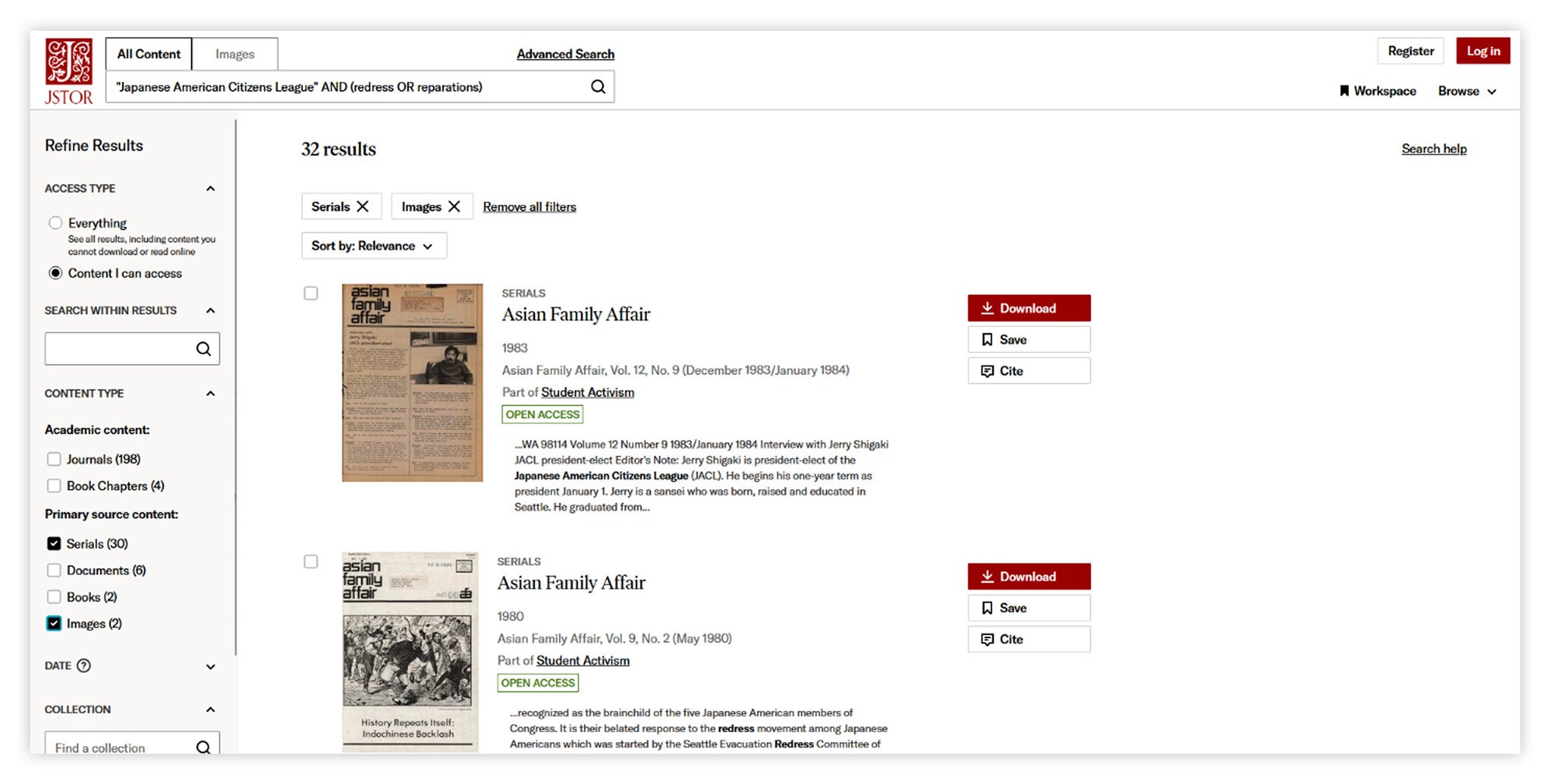Most of the classes I teach are introductory United States History courses, and my students require a bit of scaffolding and support when it comes to writing their first research paper. They might be learning some of the skills required for this task in their English courses, but I don’t want to assume that their English teachers and professors are homing in on the same skills that I’d like them to know for historical thinking. After all, each discipline approaches critical thinking and questioning in a slightly different manner.
The purpose of this article isn’t to provide the singular way to set up a research paper, but to show the way I often scaffold the process for students in my own classes. It’s my hope that each person will take these resources and change them to fit their own course and student population needs.
An Example: Japanese American Reparations
Let’s dive into the five basic steps of my process. To provide a specific research item for our example, we’ll assume that our student is researching the redress/reparations movement for Japanese Americans that led to the Civil Liberties Act of 1988. In each step, I’ll provide an explanation of the activity, how it might be scored, and where it might fit in to a sixteen-week course.
Step 1: Historical Questioning
One of the foundational skills that I start with in my class is asking historical questions. That is, instead of asking why or how something happened, students are encouraged to ask questions that make connections and challenge assumptions.
For example:
| Instead of…. | Try… |
| “Why is the United States so obsessed with boats starting wars?” | “What weight does the attack on US naval vessels carry in comparison to other factors in determining declarations of war over time?” |
| “How many people in the American Revolution were loyalists vs. patriots?” | “For those who changed their support from one side to another during the American Revolution, what changed their mind and when?” |
| “Why is there so much violence in some parts of the country and not others?” | “If crime is measured in different ways by different agencies across the nation, how can we gain a clear understanding of ideas like ‘violent crime’?” |
If your students struggle with this concept, a great way to start them on the right track is with a simple JSTOR Daily assignment in the first weeks of class. I usually try to aim for using an activity like this in the second or third week.
If your students are already prepared with this skill, they’re ready for the first step of the research project—asking a historical question to research! Here are the instructions that I would provide to students for this activity: Asking Scholarly Questions with JSTOR Daily.
Step 2: Secondary Sources
Once students have been provided with feedback (by their teacher or peer review) on their historical question for research, it’s time to start reading some secondary sources. This is a great time to remind students of the difference between primary and secondary sources. JSTOR also has some amazing tutorials on how to search their database for exactly what you need!
For this portion of the project, students will demonstrate what they’ve learned from their secondary source research. Sometimes this can take the form of a formal annotated bibliography, but my assignment tends to be less formal.
Here is what I want to know from them:
- What articles did you find?
- What did you learn from them? (not a summary)
- What questions did they lead you to ask?
- What types of primary sources referenced in the article do you want to research yourself?
Below is how I would instruct students to complete this activity, as well as the rubric and an example for them to see:
Because secondary research involves a lot of reading and can take quite a while for some students, I usually recommend starting this phase of the process after the first quarter of the course has finished. By the end of the first four weeks, students are usually more comfortable with class expectations and the instructor’s teaching and assessment style. They’re ready to jump into a larger project. It’s also perfectly fine for students to still be finishing up their secondary reading while they begin the next phase of the project—primary source research.
Step 3: Primary Sources
The third step of the research paper project, establishing primary sources, is often the most difficult part for students (other than writing the paper). Before they begin this section, we do a quick reminder of the difference between primary and secondary sources. Since students are likely still dabbling in secondary research, this distinction is especially important in this phase. I usually want students to begin their primary source research by no later than the mid-point of the class so they have plenty of time to dive fully into and explore collections they find for a few weeks before writing.
For a larger research project, students will likely pull primary sources from a variety of places. Since the purpose of this assignment is to teach them the fundamentals, we can stick to the fantastic set of primary sources available from JSTOR and help them stay in one place. For my paper on redress for Japanese Americans, the secondary research pointed me in the direction of the Japanese American Citizens League. From there, we can type that into the search bar along with our other narrowing terms.

In this search, I narrowed the search “Japanese American Citizens League” AND (redress OR reparations) to primary sources by using the “primary source content” check boxes on the left-hand side of the screen. Since my secondary source assignment indicated that I would be interested in images and newspapers, I limited my primary search to Serials and Images for the first glance.
For this part of the research process, students will complete an assignment that looks very similar to that provided above under Step 2: Secondary Sources. The activity for primary sources is attached below, including the rubric and example.
Step 4: Refine and Write
Now that students have the bulk of their research completed, it’s time to put it all together! In this part of the research process, students should take the opportunity to refine their thinking. I always remind my students that the evidence should drive their research—it’s okay if assumptions they had at the start of the process turned out to be incorrect. Their job now is to refine those assumptions into evidence-backed arguments for their paper.
I ask students to write one paragraph of their paper to turn in for peer review. In my class, each body paragraph of their paper should start with a topic sentence that presents the argument for that paragraph, followed by the evidence to support it. This activity gives students the opportunity to “soft launch” one of their arguments and the evidence they have for peer review before they write the entire paper.
This is also a great time to point out to students the “citation” function in JSTOR.

In the image above, each article has three action buttons to the right of the bibliographical information: Download, Save, and Cite.

When students click on the Cite button, JSTOR provides them with the information necessary for the three major citation styles. However, it’s important to note that if a student needs an in-text citation, they’ll need to refer to their citation guide for that information.
In my class, the peer review paragraph assignment is optional. I usually ask students to submit the assignment no later than two weeks prior to the final due date so they’ll have time to receive feedback and edit their paper. If a student feels confident in their writing and their research, they aren’t required to submit one. But for the students who choose to (which tends to be most), I’ve included the instructions below.
Step 5: The Final Product
The last step of this process is obviously for students to submit their final paper. While I usually ask students to submit this in the final week of class, other instructors may choose to ask for it earlier to allow for more grading time.
Because I teach college, I have a lot of flexibility over my own grading policies. As such, I make the entire research paper project a single graded component of my class worth about 20 percent of the course grade and make each portion of the project worth a sub-divided part of that percentage. Steps 1–4 above are usually worth an extremely small amount of the grade since their purpose is to track overall progress and provide feedback. This means that even if a student doesn’t do particularly well on one of the parts, the grade is low stakes. My syllabus also dictates that if a student wants to qualify for grade rounding (ex: a 79 to 80), they must complete every single graded assignment. This encourages students to do these low-stakes activities, even if they don’t contribute a large amount to the overall grade.
Since not everyone has the same flexibility over their grading schema, I’ve provided a rubric below for the entire research paper that incorporates Steps 1–5 into one singular grade.
Support JSTOR Daily! Join our membership program on Patreon today.






